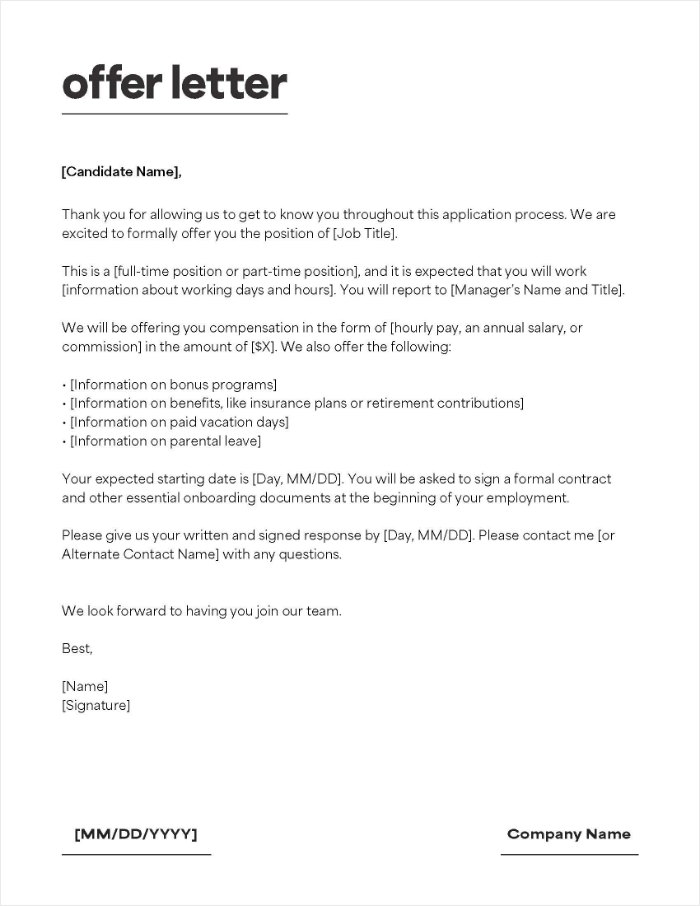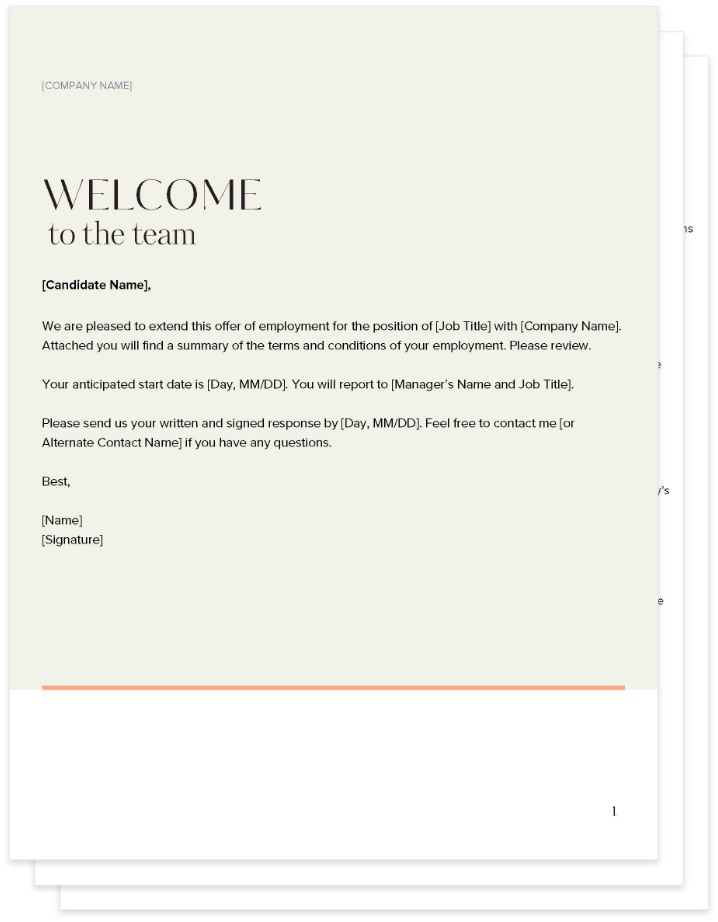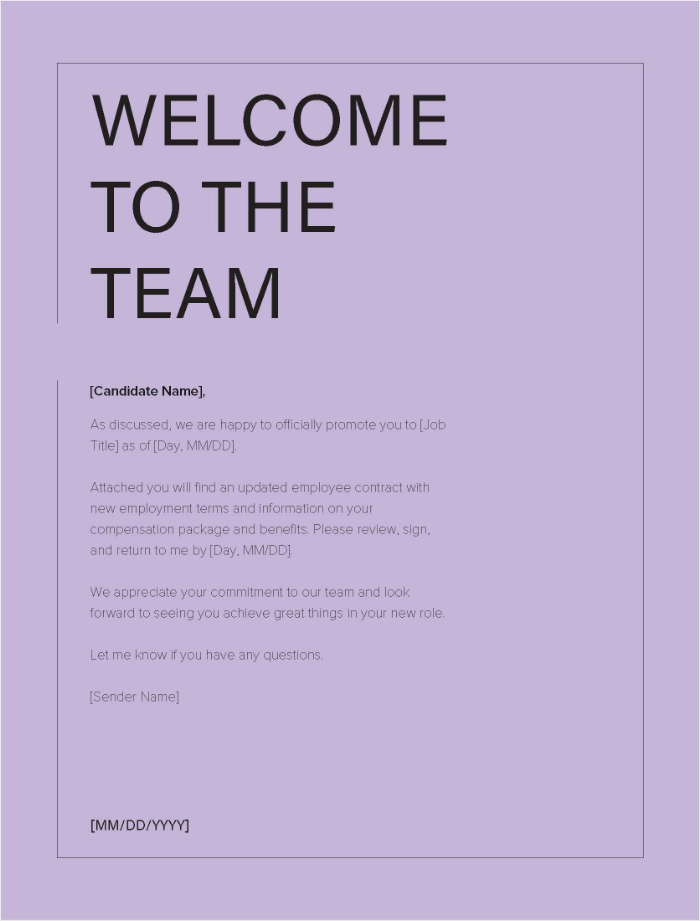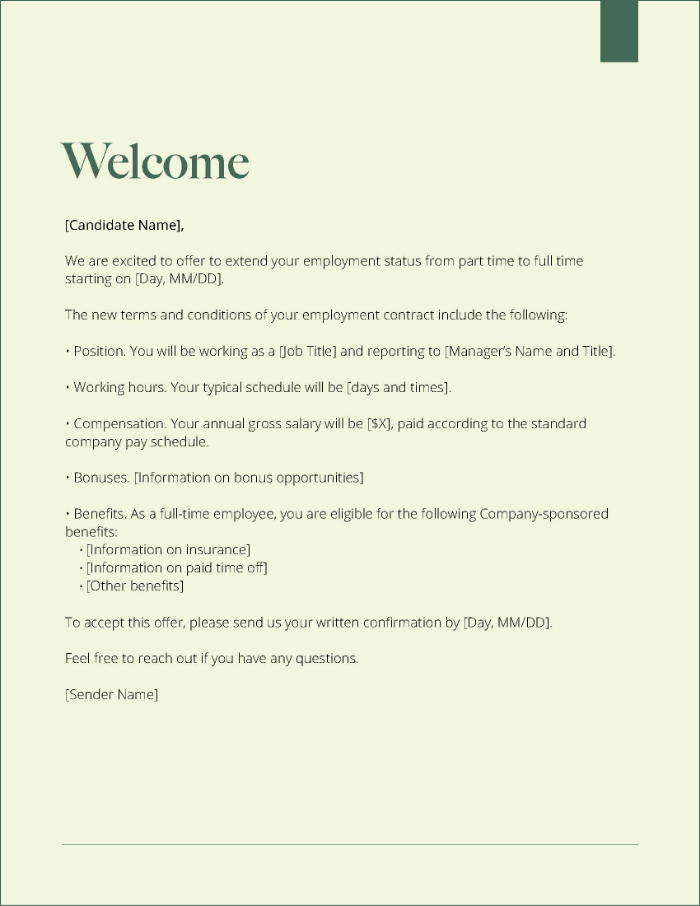ACROBAT
5 offer letter templates for any type of job.
Send an informative offer letter to secure top talent for your team.

What is an offer letter?
Once you’ve identified your top candidate, you’ll want to promptly extend a verbal offer and then follow up with an emailed offer letter.
This offer letter is not the same as an employment contract. The purpose of an offer letter is to give the candidate all the essential information they need to consider and accept the position.
After they’ve signed the offer letter, you can move on to gathering more information (such as background and reference checks) and negotiating the final employment contract. If the offer is rejected, you can move on to other top candidates. Most frequently, you send an offer letter over email and request an e-signature to accept the offer.
What should an offer letter include?
An offer letter will help the candidate feel confident about their choice to work with you. You want them to have all the information they need to commit to your company and be excited about it. Make sure your offer includes these things:
- Company letterhead. Make sure this is high resolution since it will help your candidate know that this is a legitimate offer and not a scam. It’s best included at the top of your letter. It will also help them connect the offer with your interviews and other communications.
- Job title and brief description. These items should have already been discussed at length during interviews, so you don’t have to make the description any longer than a few sentences. The job title and description are an important reminder to the candidate of which job they’re accepting, as it’s possible they applied for more than one position in your company.
- Compensation and benefits. It’s good to give details on compensation since that will help your candidate feel confident enough to accept the job. Details include the hourly wage or yearly salary, pay schedule (and maybe even methods), vacation days, health insurance, and retirement benefits. You won’t want to overwhelm them with the details you might have in an onboarding packet, though. You just want the candidate to have a clear picture of the total pay and benefits they can expect from your company.
- Contingencies and termination conditions. Make sure that your candidate isn’t taken off guard if there are a few extra requirements you have to make sure they meet before they’re officially hired. In fact, an offer letter is a great opportunity to include forms for them to fill out or information about background checks. You’ll also want to briefly reference the at-will employment law in your state. These are areas of the letter that might be helpful to review with a lawyer.
- Contact information. If your candidate has any questions about the offer, you want them to be able to reach you quickly. Include a phone number and email, and encourage them to reach out promptly with questions or concerns.
- Deadline. Deadlines help prompt the job candidate to respond to the offer instead of leaving you hanging. They’re also a sort of insurance in case your top pick ghosts you, establishing a set date after which you can reach out to the next candidate.
- Signature line. Include a clear request with your deadline to send the letter back with a signature. This can be the starting point for your employment contract. Using a PDF and Adobe’s online e-signature tools can make it easy for your prospective employee to get back to you sooner.
These are just the key elements of an offer letter. You’ll find more examples of what to include in an offer letter in the sample letters included later in this article.
Tips for writing a job offer letter.
With some good templates and a little bit of practice, you’ll find that writing a solid job offer letter is not a difficult part of the hiring process.
-
Always verbally offer the job first.
If you have a verbal conversation first, you’ll know that they’re expecting the offer letter. You’ll also have an idea of how interested they are and be able to nail down a start date. -
Stay informative and brief.
You want to make sure that every sentence you’re using has an informative purpose. Getting thorough information is the main way your candidate can weigh their options and hopefully choose your company. Remember to focus on offering information that can help with this decision-making. -
Keep your letter professional.
This includes a direct subject line that encourages the prospective employee to open your email. It also helps if you send your offer letter as a PDF.
As a bonus, try to make the tone of your job offer reflect your company culture. It will help the candidate understand what it will be like to work with your company and decide if they’ll be a good fit.
Whether you’re fairly new to writing job offers or you just want to increase your efficiency, our templates can help. Simply download an employment offer letter template from the selection below and fill in the appropriate information. Remember that these are samples, not strict outlines, so they’re fully customizable. Open your PDF letter sample with Adobe Acrobat online services to edit and fill out the PDF for free.
General offer letter template.
This template covers all the most common elements you’ll need when you extend an offer letter to a candidate. You can always use this as a jumping-off point and customize any part of it, or you can keep scrolling to see more specific samples.
Download the general offer letter template here.

Formal offer letter template.
Use a formal job offer letter template if your company has a more formal approach to communications. This way, your candidate can get a flavor of your company culture while accepting the job. As always with a template, you can adjust the wording to best suit your needs.
Follow this link to download the formal offer letter template.

Casual offer letter template.
If your company culture is a bit more laid-back, use this template to offer an opening to your top candidate. This template will reflect your company’s relaxed tone and voice so that they’re not surprised with more casual communications in the future.
Download the casual offer letter template here.

Internal offer letter template.
Because current employees will already be familiar with your company, internal offer letters can usually be much simpler than external ones. Use this template to offer your employee a promotion in clear terms.
Here’s the link to download the internal offer letter sample.

Part- to full-time offer letter template.
Use this offer letter to extend an employee’s status from part-time to full-time. Detail how their duties and responsibilities will change and the new benefits they are now eligible to receive.
Download the full- and part-time offer letter template.

Offer letter FAQ.
An offer letter is the first step to bringing your chosen candidate onto your team. Find answers to your most common questions below.